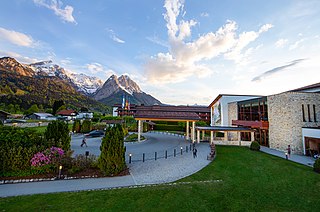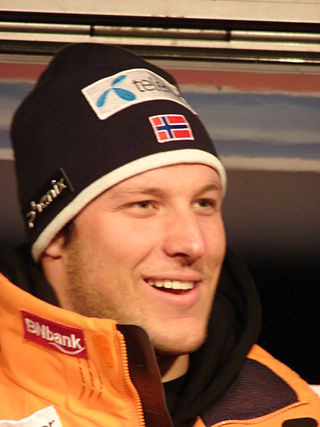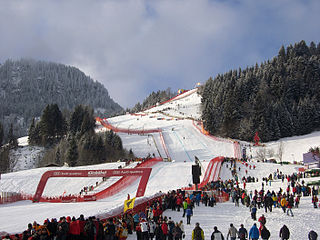Related Research Articles

The 1936 Winter Olympics, officially known as the IV Olympic Winter Games and commonly known as Garmisch-Partenkirchen 1936, were a winter multi-sport event held from 6 to 16 February 1936 in the market town of Garmisch-Partenkirchen, Germany. The country also hosted the 1936 Summer Olympics, which were held in Berlin. It was the last year in which the Summer and Winter Games both took place in the same country.

Garmisch-Partenkirchen ; Bavarian: Garmasch-Partakurch) is an Alpine ski town in Bavaria, southern Germany. It is the seat of government of the district of Garmisch-Partenkirchen, in the Oberbayern region, which borders Austria. Nearby is Germany's highest mountain, Zugspitze, at 2,962 metres (9,718 ft) above sea level.

The Four Hills Tournament or the German-Austrian Ski Jumping Week is a ski jumping event composed of four World Cup events and has taken place in Germany and Austria each year since 1953. With few exceptions, it has consisted of the ski jumping events held at Oberstdorf, Garmisch-Partenkirchen, Innsbruck and Bischofshofen, in this order.

Seefeld in Tirol is an old farming village, now a major tourist resort, in Innsbruck-Land District in the Austrian state of Tyrol with a local population of 3,312. The village is located about 17 km (11 mi) northwest of Innsbruck on a plateau between the Wetterstein mountains and the Karwendel on a historic road from Mittenwald to Innsbruck that has been important since the Middle Ages. It was first mentioned in 1022 and since the 14th century has been a pilgrimage site, benefiting not only from the visit of numerous pilgrims but also from its stacking rights as a trading station between Augsburg and the Venice. Also since the 14th century, Tyrolean shale oil has been extracted in the area. Seefeld was a popular holiday resort even before 1900 and, since the 1930s, has been a well known winter sports centres and amongst the most popular tourist resorts in Austria. The municipality, which has been the venue for several Winter Olympics Games, is the home village of Anton Seelos, the inventor of the parallel turn.
The FIS Alpine World Ski Championships 2011 were the 41st FIS Alpine World Ski Championships, held 7–20 February in Germany at Garmisch-Partenkirchen, Bavaria.

Edelweiss Lodge and Resort is a U.S. Department of Defense owned recreation hotel in Garmisch-Partenkirchen, Germany. Located in the Bavarian Alps near the Austrian border, the facility opened in September 2004 at a cost of $80 million.

The Große Olympiaschanze is a ski jumping hill located on the Gudiberg, south of the district of Partenkirchen of Garmisch-Partenkirchen, Bavaria, Germany, and is traditionally the venue of the Four Hills Tournament's New Year's jumping.

The 43rd World Cup season began in late October 2008 in Sölden, Austria, and concluded in mid-March 2009, at the World Cup finals in Åre, Sweden.

The Wetterstein mountains, colloquially called Wetterstein, is a mountain group in the Northern Limestone Alps within the Eastern Alps. It is a comparatively compact range located between Garmisch-Partenkirchen, Mittenwald, Seefeld in Tirol and Ehrwald along the border between Germany (Bavaria) and Austria (Tyrol). Zugspitze, the highest peak is at the same time the highest mountain in Germany.

Garmisch Classic is an alpine ski area in the Bavarian Alps of southern Germany, near Garmisch-Partenkirchen, Bavaria. Its maximum elevation is 2,050 m (6,726 ft) above sea level at Osterfelderkopf, with a vertical drop of 1,350 m (4,429 ft). Other peaks of ski area are the Kreuzjoch at 1,719 m (5,640 ft) and Kreuzeck at 1,651 m (5,417 ft).

Gudiberg is a mountain of Bavaria, in Garmisch-Partenkirchen, Germany. It lies south of the centre of Partenkirchen and east of the Partnach river.

The Kreuzeck is a mountain in the Wetterstein mountain range of Bavaria, Germany with an elevation of 1,651 m (5,417 ft) above sea level. It is part of the present-day Garmisch Classic ski resort.
For the 1936 Winter Olympics in Garmisch-Partenkirchen, Germany, a total of six sports venues were used. Alpine skiing events took place for the first time and were held in three different locations. Riessersee held the speed skating and some of the ice hockey matches while the bobsleigh events took place south of the lake. The ski jump and its neighboring stadium played host to the cross-country skiing, Nordic combined, and ski jumping events. Even though figure skating and some of the ice hockey matches took place outdoors at the ice stadium, the ice itself was artificially refrigerated to prevent ice thawing.

The Ausserfern Railway is a cross-border railway line in the German state of Bavaria and the Austrian state of Tyrol. The single-tracked branch line starts from Kempten in Germany, before crossing into Austria just after passing through Pfronten. It then transits the Außerfern area around Reutte, before passing back into Germany in order to terminate at Garmisch-Partenkirchen.
The Hausberg Gondola Lift runs from Garmisch-Partenkirchen in South Germany up to the Hausberg mountain and the "Classic" ski area of Hausberg-Alpspitze. It belongs to the Bayerische Zugspitzbahn company and is only operated in winter.

Hausberg is German for a prominent mountain or hill in the immediate vicinity of a village, town or city, usually located on its municipal territory, but outside the built up area. It means something like the "local mountain" or "local hill" closely associated with a settlement by its population. The Hausberg forms a backdrop to its home settlement and also offers a prominent viewing point looking over the settlement. As a result, many Hausberge have cable cars or gondola lifts to transport visitors to the top. "Hausberg" is also the proper name of numerous local mountains and hills in German-speaking countries.

Streif is a World Cup downhill ski course in Austria, located on Hahnenkamm mountain in Kitzbühel, Tyrol, competing for the Hahnenkamm Races since 1937.
Garmisch-Partenkirchen Hausberg station is a railway station in the municipality of Garmisch-Partenkirchen, located in the Garmisch-Partenkirchen district in Bavaria, Germany.

Kandahar is a classic World Cup downhill ski course in southern Germany. Located in Bavaria at the Garmisch Classic ski area on the Zugspitze above Garmisch-Partenkirchen, it opened 87 years ago in 1936.